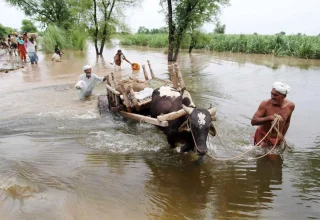
The Provincial Disaster Management Authority (PDMA) Punjab has released its latest damage assessment report, revealing the scale of destruction caused by ongoing floods across the province.
According to PDMA, over 4,700 villages (mauzas) have been affected due to flooding in the Ravi, Sutlej, and Chenab rivers. The Chenab River remains the worst hit, with 2,475 villages inundated, followed by 1,458 villages along the Ravi and 715 along the Sutlej.
Relief Commissioner Nabeel Javed said that 4.574 million people have been directly affected by the floods so far. Rescue teams have managed to evacuate 2.516 million people to safer locations.
Authorities have established 372 relief camps across flood-hit districts, along with 459 medical camps to provide healthcare to displaced communities. In addition, 391 veterinary camps have been set up for livestock, with 2.02 million animals relocated to safe areas.
The report confirmed that 104 people have lost their lives in various flood-related incidents.
Officials said relief efforts continue on a war footing, with drone-assisted rescue operations being carried out to locate and evacuate stranded residents.
Power Division restores power for 1.47 million flood-affected consumers
The Ministry of Energy (Power Division) has issued its latest report on electricity restoration efforts in flood-affected areas, showing significant progress across multiple power distribution companies despite challenging conditions.
According to the report, a total of 51 grid stations and 543 feeders across several regions were impacted by flooding. So far, 309 feeders have been fully restored and 226 partially restored, allowing electricity supply to resume for 1,478,931 consumers out of a total of 1,801,225 affected. Restoration work for the remaining 322,294 consumers is being prioritized.
In Faisalabad Electric Supply Company (FESCO)’s jurisdiction, 28 grid stations and 81 feeders were affected in Toba Tek Singh, Faisalabad, Chiniot, Jhang, Sargodha, Mianwali, and Dera Ismail Khan. Of these, 36 feeders have been fully restored and 44 partially restored. Power has been restored to 138,550 consumers out of 203,844, while work for the remaining 65,294 will be completed by September 15, subject to water receding.
In Lahore Electric Supply Company (LESCO) areas, including Lahore, Okara, Sheikhupura, Kasur, and Nankana Sahib, 63 of 67 affected feeders have been fully restored and four partially restored. Power supply is now available to 68,909 consumers out of 73,734, with full restoration expected by the end of September 14. LESCO confirmed that restoration in Lahore, Nankana Sahib, and Sheikhupura is already complete.
In Multan Electric Power Company (MEPCO)’s region, 180 feeders were affected. Seven feeders have been fully restored and 166 partially restored. Out of 268,846 affected consumers, 20,925 now have electricity. MEPCO stated that full-scale restoration will begin as soon as floodwaters recede.
In Gujranwala Electric Power Company (GEPCO)’s region, 11 grid stations and 103 feeders were affected. Power has been fully restored to 96 feeders and partially to 7, bringing electricity back for 734,857 consumers out of 735,987. The remaining 1,130 consumers will have power once water levels drop.
In Peshawar Electric Supply Company (PESCO) areas, including Swat, Buner, Shangla, Swabi, and Dera Ismail Khan, 12 grid stations and 91 feeders were affected. Power has been fully restored to 87 feeders and partially to 4, with electricity restored for 461,247 consumers out of 463,375. PESCO confirmed that power restoration is now complete in Swat, Swabi, and Dera Ismail Khan.
In Tribal Electric Supply Company (TESCO)’s region covering North Waziristan and Khyber, 17 of 18 feeders have been fully restored and one partially restored, bringing electricity back for 30,778 consumers out of 31,774. Full restoration is expected by September 15 at 5 PM.
In Hazara Electric Supply Company (HESCO)’s Mansehra region, all three affected feeders have been fully restored.
The Power Division emphasized that restoring electricity to the remaining consumers is its highest priority and assured that work will be completed as soon as floodwaters allow access to damaged infrastructure.






























